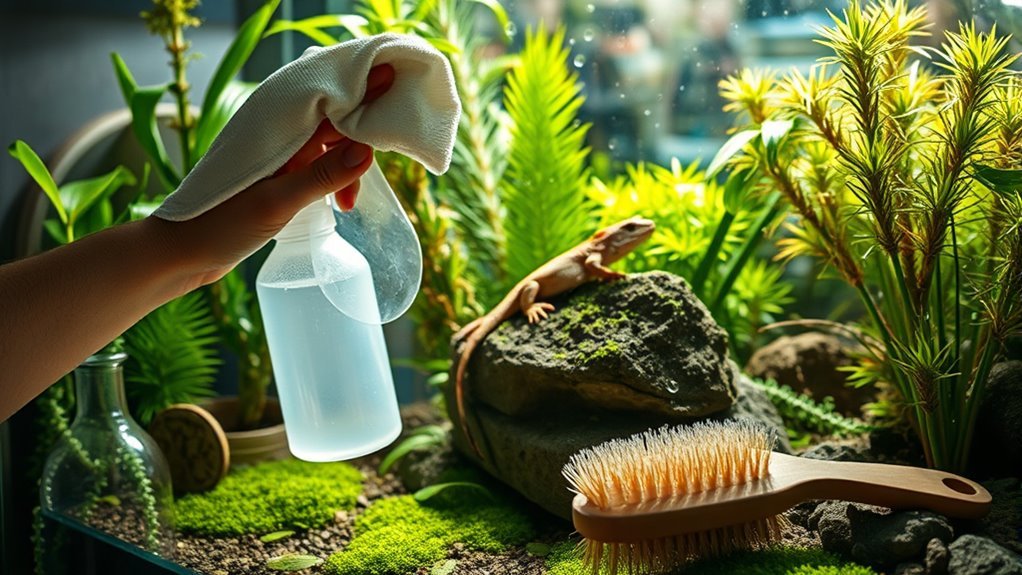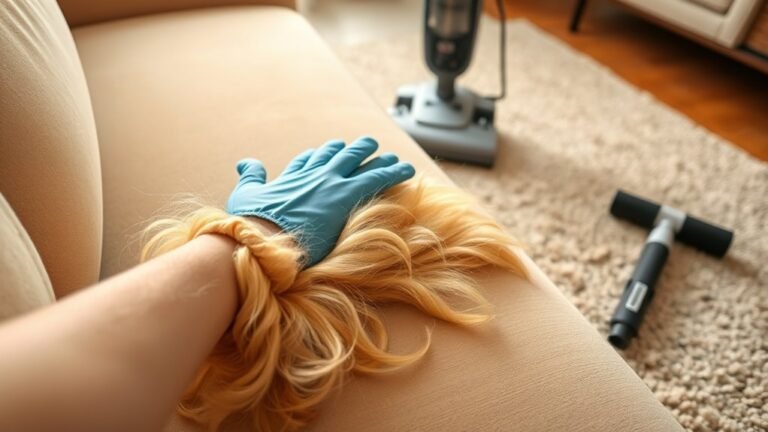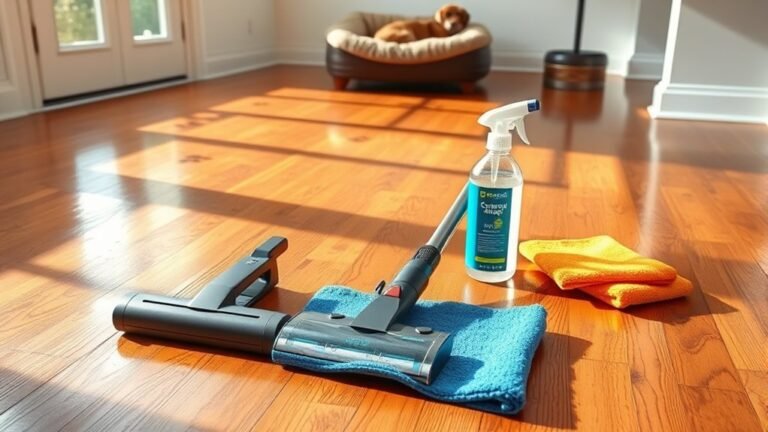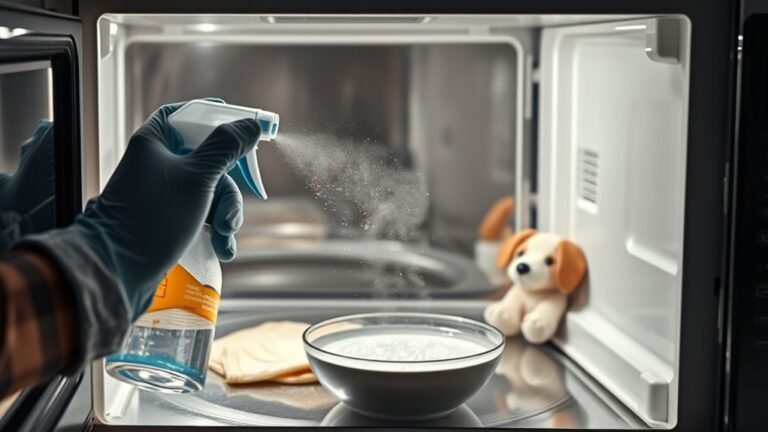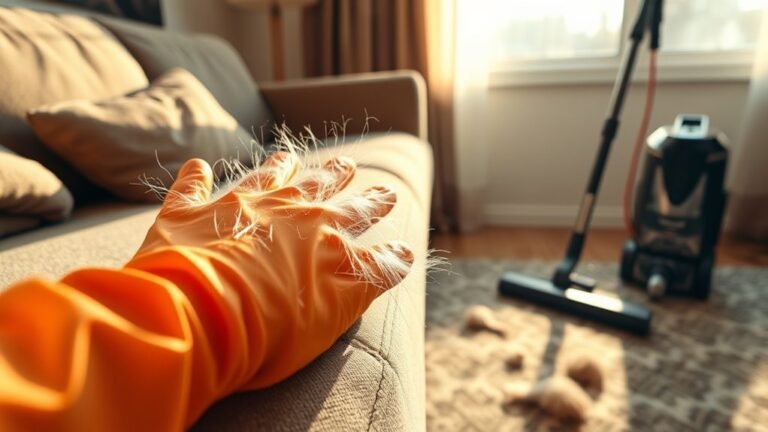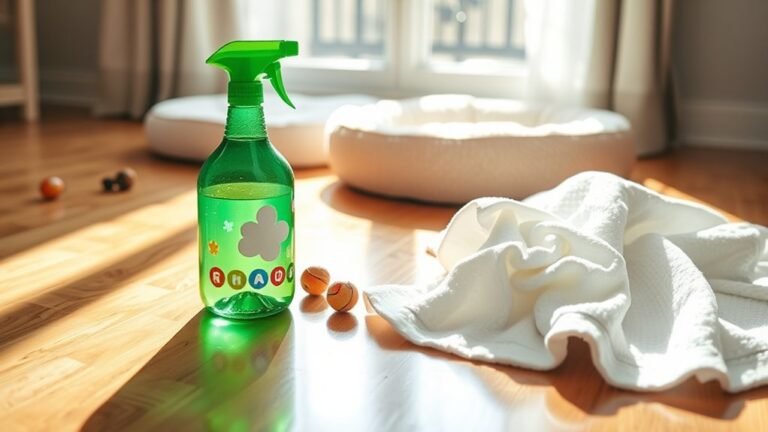Cleaning and Maintaining a Reptile Terrarium
You should clean your reptile terrarium regularly using safe, reptile-friendly supplies like natural sprays and mild disinfectants. Spot clean daily by removing waste and wiping surfaces, while doing a deep clean weekly—removing substrate and decorations to disinfect everything thoroughly. Maintain proper humidity and temperature with reliable tools, and replace substrate as needed to prevent mold and bacteria. Proper waste disposal and hygiene keep your pet healthy. Keep going to discover detailed tips and best practices for a thriving terrarium.
Choosing the Right Cleaning Supplies for Your Terrarium
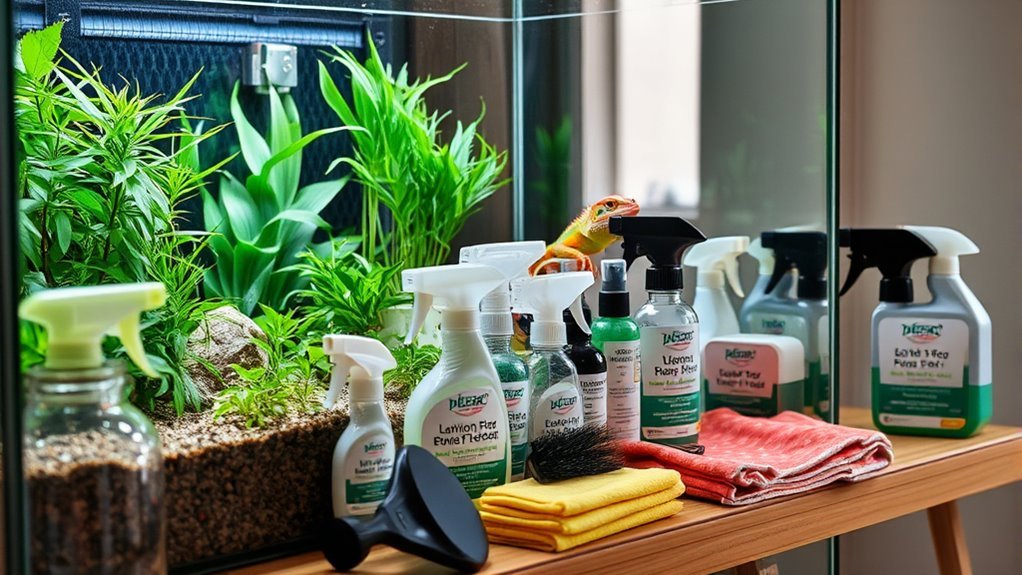
Before you begin cleaning your reptile terrarium, it’s important to pick the right supplies to guarantee a safe and effective process. You want products that protect your pet and the environment, so eco friendly options like natural sprays, vinegar solutions, and biodegradable wipes are ideal. These choices minimize harmful chemicals and let you keep your terrarium spotless without compromising your reptile’s health. Also, consider how often you’ll clean; more frequent cleaning means you can rely on gentler products, while deep cleans might call for stronger but still safe solutions. By choosing wisely, you maintain a healthy habitat while respecting your values and your pet’s needs—giving you the freedom to enjoy a clean terrarium without worry.
Daily Spot Cleaning Tips for Reptile Enclosures
Keeping up with daily spot cleaning can make a big difference in maintaining your reptile’s health and comfort. By focusing on spot cleaning techniques, you can quickly remove waste, uneaten food, and shed skin without disturbing your pet’s environment. Start by using a small scoop or tweezers to pick up debris, then wipe down any soiled areas with a reptile-safe disinfectant. Daily maintenance tips like checking water dishes and removing moldy substrate help prevent bacteria buildup and odors, ensuring a fresh terrarium. Staying consistent with these quick tasks frees you from larger, more disruptive cleanings and keeps your reptile’s space inviting. Embrace these simple steps, and you’ll enjoy a healthier habitat with less hassle and more freedom.
Weekly Deep Cleaning Procedures
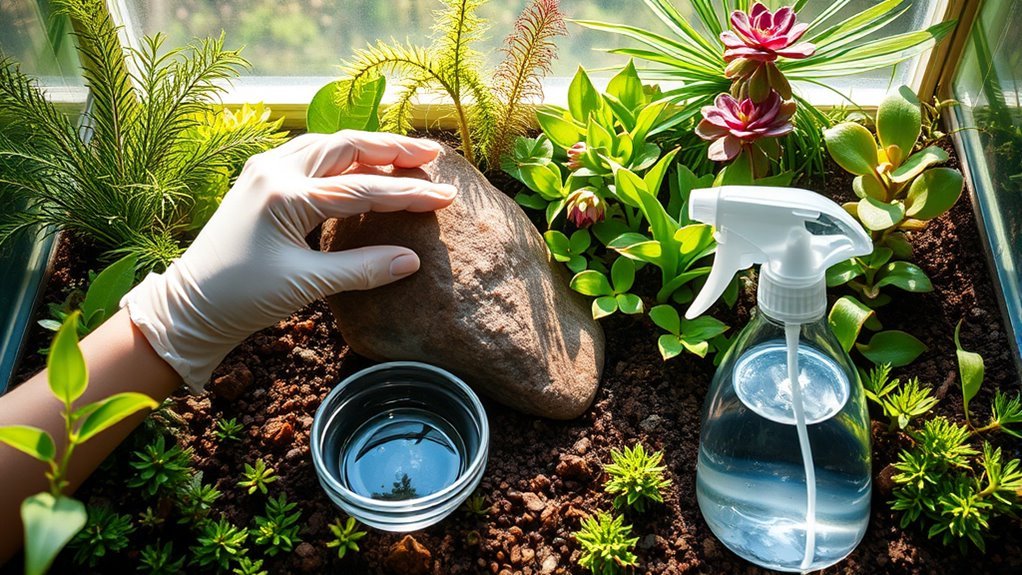
While daily spot cleaning helps maintain your reptile’s environment between major cleanings, weekly deep cleaning guarantees a thoroughly healthy habitat. You’ll want to remove your terrarium inhabitants temporarily to verify their safety. Next, take out all decorations, substrate, and water bowls. Clean the glass, walls, and floor with a reptile-safe disinfectant to eliminate bacteria and waste buildup. Replace the substrate entirely to prevent mold and mites. Wash and rinse all items thoroughly before returning them. This cleaning frequency helps prevent health issues and keeps your reptile’s space fresh. By committing to weekly deep cleaning, you’re giving your reptile the freedom to thrive in a clean, comfortable environment without unnecessary stress or exposure to harmful pathogens.
Monthly Maintenance Checklist
Every month, you’ll want to inspect the substrate to guarantee it’s still clean and safe for your reptile. Don’t forget to thoroughly clean the water and food dishes to prevent bacteria buildup. Also, check the heating elements to confirm they’re working properly and providing the right temperature.
Inspect Substrate Condition
Because the substrate directly impacts your reptile’s health, you should inspect its condition regularly. Different substrate types—like coconut fiber, reptile carpet, or sand—offer unique benefits, from moisture retention to ease of cleaning. Check for damp spots, mold, or waste buildup that can foster bacteria or parasites, threatening your pet’s well-being. If the substrate looks compacted or smells off, it’s time to replace it. Regular inspection guarantees a clean, comfortable environment where your reptile can thrive and move freely. Staying on top of substrate care means less stress for your scaly friend and more freedom for you, knowing their habitat supports natural behaviors and health. Keep your terrarium fresh and safe by making this a monthly habit.
Clean Water and Dishes
Two key steps in monthly terrarium upkeep are cleaning your reptile’s water and dishes. Ensuring excellent water quality is essential, so replace the water with fresh, filtered or dechlorinated water to keep your pet healthy and hydrated. Stagnant or dirty water can harbor bacteria, risking your reptile’s wellbeing. Next, focus on dish hygiene by scrubbing the water and food dishes with a reptile-safe disinfectant or mild soap. Rinse thoroughly to avoid harmful residue. Regular cleaning prevents mold buildup and keeps your terrarium environment fresh and inviting. By maintaining clean water and dishes, you’re giving your reptile the freedom to thrive in a safe, healthy habitat, all while simplifying your own maintenance routine. Don’t skip this step—it’s crucial for their lasting vitality.
Check Heating Elements
Inspect the heating elements in your terrarium regularly to guarantee they’re working properly and keeping your reptile comfortable. Start by checking bulbs, heat mats, or ceramic heaters for any signs of wear or damage. Ensuring ideal heating efficiency is essential—old or malfunctioning elements can cause temperature fluctuations that stress your pet. Pay close attention to thermostat placement; it should be near the reptile’s basking area but away from direct heat sources to provide accurate temperature readings. Replace faulty thermostats or heating devices immediately to maintain a stable environment. By consistently monitoring heating elements, you give your reptile the freedom to regulate its body temperature naturally, promoting health and well-being without unnecessary risk. This simple step keeps your terrarium safe and your pet thriving.
Managing Humidity Levels in the Terrarium
You’ll want to keep your reptile’s terrarium within its ideal humidity range to guarantee its health and comfort. Using tools like hygrometers can help you monitor moisture levels accurately. Let’s look at how to maintain the right balance for your pet’s environment.
Ideal Humidity Range
Although maintaining the right humidity levels might seem tricky, it’s imperative for your reptile’s health and comfort. Every species thrives within a specific ideal humidity range, usually between 40% and 80%. You’ll want to research your reptile’s natural environment to set this range accurately. Using reliable humidity sources like misting systems, water dishes, and live plants helps keep the terrarium balanced. Too low, and your reptile risks dehydration; too high, and mold or respiratory issues may develop. Consistent humidity monitoring is essential to guarantee these levels stay within the ideal range. By mastering humidity control, you give your reptile the freedom to thrive in an environment that mirrors its wild habitat, promoting well-being and reducing stress.
Tools for Monitoring
A reliable hygrometer is essential when managing humidity levels in your reptile’s terrarium. It gives you accurate readings so you can maintain the ideal environment without guesswork. Alongside humidity monitors, temperature gauges play an important role in monitoring your terrarium’s microclimate. Together, these tools help you keep conditions stable, ensuring your reptile thrives. You don’t have to rely on guesswork or outdated methods—modern digital monitors provide real-time data with minimal effort. By regularly checking these instruments, you can quickly adjust misting schedules, ventilation, or heating devices to keep humidity and temperature within the right ranges. Embracing these tools grants you the freedom to create the perfect habitat, simplifying maintenance and promoting your reptile’s health effortlessly.
Monitoring and Adjusting Temperature Settings
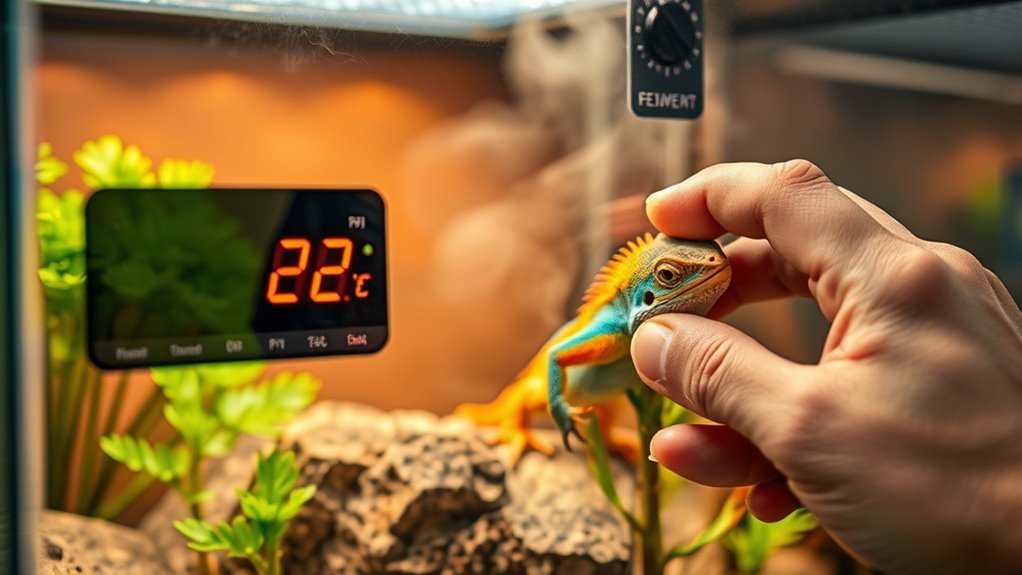
When maintaining your reptile’s terrarium, keeping a close eye on temperature settings is essential to secure your pet’s health and comfort. You’ll want to use reliable monitoring devices like digital thermometers or thermostats to track temperature fluctuations throughout the day. These tools help you spot any unsafe changes quickly, so you can adjust heating elements as needed. Don’t rely on guesswork—consistent monitoring guarantees your reptile’s environment stays within the ideal range, promoting their natural behavior and well-being. Remember, sudden temperature swings can stress your pet, so aim for stability. Adjust heat lamps, pads, or ceramic heaters accordingly, and keep an eye on both basking and cooler zones to create a comfortable gradient your reptile can freely explore.
Handling Substrate Replacement and Care
When it’s time to replace your reptile’s substrate, you’ll want to choose materials that are safe and suitable for their species. Proper cleaning techniques help prevent bacteria buildup and keep the environment healthy. You should also consider how often to replace the substrate to maintain a fresh and comfortable habitat.
Choosing Safe Substrates
Although selecting the right substrate might seem straightforward, it’s essential to pick materials that are safe and suitable for your reptile’s species. You can choose between natural substrates like coconut fiber or organic soil, and synthetic substrates such as reptile carpet or paper towels. Prioritize substrate safety by avoiding anything that could cause impaction or harbor bacteria. Consider substrate layering to create a more natural environment, enhancing environmental enrichment and allowing your reptile to burrow or hide. Managing substrate moisture is equally important; too wet or too dry can harm your pet’s health. By carefully selecting and maintaining your substrate, you give your reptile a comfortable, safe space where it can thrive freely, matching its natural habitat as closely as possible.
Cleaning Techniques
Maintaining a clean terrarium is essential for your reptile’s health, and handling substrate replacement properly plays a big part in that. Start by removing soiled substrate carefully to avoid stirring up dust or bacteria. Use gentle cleaning techniques like spot cleaning daily and partial substrate replacement weekly following your cleaning schedules. When you replace substrate, do it in sections rather than all at once, allowing your reptile some familiar territory to reduce stress. Always disinfect the terrarium base before adding fresh substrate to prevent buildup. Remember, consistent cleaning techniques will keep your reptile’s environment healthy and odor-free. Sticking to a regular cleaning schedule guarantees your pet stays happy and disease-free, giving you the freedom to enjoy your reptile without worries about its habitat.
Replacement Frequency Tips
Since regular substrate replacement is essential for your reptile’s health, understanding how often to do it can save you time and stress. Replacement timing depends on the substrate type and your pet’s habits. To keep your terrarium fresh and safe, consider these guidelines:
- Monitor substrate lifespan: natural substrates often last 1–3 months; synthetic ones can last longer.
- Spot-clean daily to extend substrate lifespan and reduce full replacements.
- Replace immediately if you notice mold, odors, or excessive waste buildup.
- Schedule full substrate changes every 1–3 months to prevent bacterial growth and maintain a healthy environment.
Disinfecting Decorations and Accessories
When it comes to disinfecting decorations and accessories in your reptile terrarium, you’ll want to guarantee they’re thoroughly cleaned without damaging their surfaces. Start by removing all decorations, including plants and rocks. For disinfecting plants, especially artificial ones, soak them in a diluted bleach solution for about 10 minutes, then rinse thoroughly to avoid harming your reptile. When sterilizing rocks, scrub off debris first, then soak them in boiling water or use a reptile-safe disinfectant to eliminate bacteria. Avoid harsh chemicals that could leave residues. After disinfecting, let everything air dry completely before placing them back. This approach keeps your terrarium fresh, safe, and your reptile free to roam in a clean environment without compromising the integrity of your décor.
Preventing and Treating Common Terrarium Mold Issues
After disinfecting your terrarium’s decorations and accessories, it’s important to keep an eye out for mold, which can quickly develop in the moist environment reptiles often require. Understanding common mold types like black mold and white mold helps you act fast. To prevent and treat mold, follow these steps:
- Monitor humidity levels regularly and keep them within your reptile’s ideal range.
- Improve ventilation by adding fans or air vents to reduce moisture buildup.
- Remove visible mold immediately using reptile-safe cleaning solutions.
- Replace substrate frequently, especially if it stays damp.
Best Practices for Waste Disposal and Hygiene
Proper waste disposal and maintaining hygiene are essential to keeping your reptile healthy and its terrarium safe. Effective waste management means promptly removing feces, shed skin, and uneaten food daily to prevent bacterial buildup. Use disposable gloves and dedicated tools to avoid cross-contamination. When cleaning, opt for reptile-safe disinfectants to eliminate pathogens without harming your pet. Good hygiene practices also include regularly washing water and food dishes and changing substrate as needed. Ventilate the terrarium well to reduce moisture, which can harbor harmful microbes. By sticking to these routines, you free yourself from constant worry about your reptile’s wellbeing and create a fresh environment that supports its natural behavior. Your commitment to these best practices guarantees your terrarium remains a thriving, clean habitat for your scaly companion.
Frequently Asked Questions
How Often Should I Replace My Reptile’S Water Bowl?
You should replace your reptile’s water bowl frequently to keep things fresh and safe. Ideally, swap it out daily or at least every couple of days, depending on how quickly it gets dirty. When it comes to bowl cleaning methods, using mild soap and warm water works well—just be certain to rinse thoroughly. Staying on top of water bowl frequency guarantees your pet stays hydrated and healthy without hassle.
Can Certain Plants Improve Terrarium Air Quality?
Think of air purifying plants as tiny guardians, silently cleansing the air and nurturing freedom within your terrarium’s ecosystem. You’ll find that certain plants not only boost air quality but also aid in humidity retention, creating a more natural, breathable environment for your reptile. By choosing the right greenery, you’re inviting a healthier, more vibrant habitat—one where both you and your reptile can thrive with a sense of untamed liberty.
What Signs Indicate My Reptile Is Stressed by Cleaning Routines?
You’ll notice behavioral signs like your reptile hiding more than usual, refusing food, or becoming unusually aggressive—these are key stress indicators. They might also pace or show changes in their usual activity levels. When you see these signs, it means your reptile’s feeling overwhelmed. To give them freedom and comfort, try adjusting your approach, making cleaning less intrusive or timing it when they’re less active, so they stay relaxed.
Is It Safe to Use Natural Sunlight for Terrarium Lighting?
When it comes to sunlight exposure, you know it’s a double-edged sword. Natural sunlight offers fantastic UVB benefits that are essential for your reptile’s health, helping with vitamin D synthesis and calcium absorption. However, you’ve got to be careful—too much direct sunlight can overheat the terrarium and harm your pet. So, while you’re free to use natural light, make sure to provide shaded areas and monitor temperatures closely to keep things safe.
How Do I Quarantine New Reptiles Before Adding Them to the Terrarium?
When you bring in new reptiles, you’ll want to set up a separate space for quarantine. The quarantine duration usually lasts about 30 to 90 days, giving you an observation period to watch for any signs of illness or parasites. This keeps your existing reptiles safe and healthy. During this time, you can freely monitor their behavior and health without risking your main terrarium’s ecosystem. It’s a smart step to protect your reptile family.
